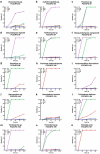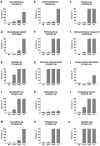Molluscicidal Screening of Hypocreales Fungi from a Brazilian Cerrado Cave Against Biomphalaria glabrata Snails
- PMID: 40137211
- PMCID: PMC11942953
- DOI: 10.3390/jof11030173
Molluscicidal Screening of Hypocreales Fungi from a Brazilian Cerrado Cave Against Biomphalaria glabrata Snails
Abstract
Fungi play vital roles in ecosystems through parasitism, commensalism, and mutualism. Additionally, they are widely used in industry as bioactive compound producers and biological control agents. Biomphalaria glabrata is a freshwater snail often controlled with chemical molluscicides. However, developing effective alternatives to these chemical treatments is essential. This study evaluated the molluscicidal potential of culture supernatant from Hypocreales fungi isolated from a cave in the Brazilian Cerrado against the B. glabrata. The isolates were identified based on morphological features and ITS rDNA sequences. Fifteen filtrates of Hypocreales fungi were obtained and tested both pure and in different dilutions (10% and 50%) against newly hatched snails during 96 h of exposure. The fungal isolates were identified as belonging to the genera of Clonostachys (1), Cylindrocladiella (1), Fusarium (1), Gliocladiopsis (1), Keithomyces (1), Marquandomyces (1), Ovicillium (1), Pochonia (1), Purpureocillium (1), Sarcopodium (1), Sarocladium (1), Trichoderma (3), and Volutella (1). The results showed 93.33% (14) of the fungal filtrates induced significant mortality, indicating their molluscicidal activity, with Pochonia chlamydosporia FCCUFG 100 and Volutella aeria FCCUFG 107 causing 100% mortality in all dilutions. These results reveal the potential of Hypocreales fungi from a Brazilian Cerrado cave as a promising approach for snail control.
Keywords: biotechnological potential; cave mycodiversity; fungal bioprospecting; fungal filtrate; gastropod control.
Conflict of interest statement
The authors declare no conflicts of interest.
Figures





Similar articles
-
Molluscicidal and parasiticidal activities of Eryngium triquetrum essential oil on Schistosoma mansoni and its intermediate snail host Biomphalaria glabrata, a double impact.Parasit Vectors. 2020 Sep 23;13(1):486. doi: 10.1186/s13071-020-04367-w. Parasit Vectors. 2020. PMID: 32967724 Free PMC article.
-
Molluscicidal and antioxidant activities of silver nanoparticles on the multi-species of snail intermediate hosts of schistosomiasis.PLoS Negl Trop Dis. 2022 Oct 10;16(10):e0010667. doi: 10.1371/journal.pntd.0010667. eCollection 2022 Oct. PLoS Negl Trop Dis. 2022. PMID: 36215300 Free PMC article.
-
Molluscicidal activity of Persea americana Mill. (Lauraceae) stem bark ethanolic extract against the snail Biomphalaria glabrata (Say, 1818): a novel plant-derived molluscicide?An Acad Bras Cienc. 2020 Nov 20;92(4):e20200715. doi: 10.1590/0001-3765202020200715. eCollection 2020. An Acad Bras Cienc. 2020. PMID: 33237149
-
Nematophagous fungus Pochonia chlamydosporia to control parasitic diseases in animals.Appl Microbiol Biotechnol. 2023 Jun;107(12):3859-3868. doi: 10.1007/s00253-023-12525-0. Epub 2023 May 6. Appl Microbiol Biotechnol. 2023. PMID: 37148335 Review.
-
Bioactivity of substances isolated from natural products on mollusks Biomphalaria glabrata (Say, 1818) (Planorbidae): a review.Braz J Biol. 2023 Jun 5;83:e266526. doi: 10.1590/1519-6984.266526. eCollection 2023. Braz J Biol. 2023. PMID: 37283371 Review.
References
-
- Cadastro Nacional de Informações Espeleológicas Home Page. [(accessed on 14 July 2024)]; Available online: https://www.gov.br/icmbio/pt-br/assuntos/centros-de-pesquisa/cavernas.
-
- Alves V.C.S., Lira R.A., Lima J.M.S., Barbosa R.N., Bento D.M., Barbier E., Bernard E., Souza-Motta C.M., Bezerra J.D.P. Unravelling the fungal darkness in a tropical cave: Richness and the description of one new genus and six new species. Fungal Syst. Evol. 2022;10:139–167. doi: 10.3114/fuse.2022.10.06. - DOI - PMC - PubMed
-
- Oliveira P.H.F., Franco R.F.F., Nogueira P.T.S., Momoli R.S., Souza-Motta C.M., Bezerra J.D.P. Treasure map: Richness of Penicillium species in the Lapa do Boqueirão cave in the Cerrado of Goiás. Rev. Bras. Espeleol. 2024;13:339–369. doi: 10.37002/rbesp.v1i13.2602. - DOI
Grants and funding
LinkOut - more resources
Full Text Sources
Research Materials

